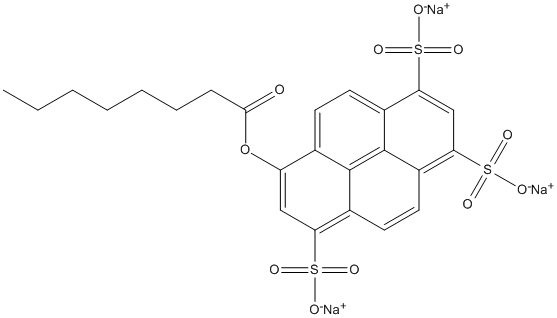OPTS
General
Type : Sulfur compound || Fatty acid ester
Chemical_Nomenclature : trisodium 8-octanoyloxypyrene-1,3,6-trisulfonate
Canonical SMILES : CCCCCCCC(=O)OC1=CC(=C2C=CC3=C(C=C(C4=C3C2=C1C=C4)S(=O)(=O)[O-])S(=O)(=O)[O-])S(=O)(=O)[O-].[Na+].[Na+].[Na+]
InChI : InChI=1S\/C24H24O11S3.3Na\/c1-2-3-4-5-6-7-22(25)35-18-12-19(36(26,27)28)15-10-11-17-21(38(32,33)34)13-20(37(29,30)31)16-9-8-14(18)23(15)24(16)17\;\;\;\/h8-13H,2-7H2,1H3,(H,26,27,28)(H,29,30,31)(H,32,33,34)\;\;\;\/q\;3*+1\/p-3
InChIKey : RZVSWISDVXUSGY-UHFFFAOYSA-K
Other name(s) : 8-Octanoyloxypyrene-1,3,6-trisulfonic acid trisodium salt, DTXSID50555893, AKOS027381908, FT-0703197

Target
Families : Pectinacetylesterase-Notum
References (5)
| Title : Structural characterisation of melatonin as an inhibitor of the Wnt deacylase Notum - Zhao_2019_J.Pineal.Res__e12630 |
| Author(s) : Zhao Y , Ren J , Hillier J , Jones M , Lu W , Jones EY |
| Ref : J Pineal Res , :e12630 , 2019 |
| Abstract : Zhao_2019_J.Pineal.Res__e12630 |
| ESTHER : Zhao_2019_J.Pineal.Res__e12630 |
| PubMedSearch : Zhao_2019_J.Pineal.Res__e12630 |
| PubMedID: 31876313 |
| Gene_locus related to this paper: human-NOTUM |
| Title : NOTUM inhibition increases endocortical bone formation and bone strength - Brommage_2019_Bone.Res_7_2 |
| Author(s) : Brommage R , Liu J , Vogel P , Mseeh F , Thompson AY , Potter DG , Shadoan MK , Hansen GM , Jeter-Jones S , Cui J , Bright D , Bardenhagen JP , Doree DD , Moverare-Skrtic S , Nilsson KH , Henning P , Lerner UH , Ohlsson C , Sands AT , Tarver JE , Powell DR , Zambrowicz B , Liu Q |
| Ref : Bone Res , 7 :2 , 2019 |
| Abstract : Brommage_2019_Bone.Res_7_2 |
| ESTHER : Brommage_2019_Bone.Res_7_2 |
| PubMedSearch : Brommage_2019_Bone.Res_7_2 |
| PubMedID: 30622831 |
| Gene_locus related to this paper: human-NOTUM |
| Title : Discovery of 2-phenoxyacetamides as inhibitors of the Wnt-depalmitoleating enzyme NOTUM from an X-ray fragment screen - Atkinson_2019_Medchemcomm_10_1361 |
| Author(s) : Atkinson BN , Steadman D , Zhao YG , Sipthorp J , Vecchia L , Ruza RR , Jeganathan F , Lines G , Frew S , Monaghan A , Kjaer S , Bictash M , Jones Y , Fish PV , Zhao Y , Jones EY |
| Ref : Medchemcomm , 10 :1361 , 2019 |
| Abstract : Atkinson_2019_Medchemcomm_10_1361 |
| ESTHER : Atkinson_2019_Medchemcomm_10_1361 |
| PubMedSearch : Atkinson_2019_Medchemcomm_10_1361 |
| PubMedID: 31534655 |
| Gene_locus related to this paper: human-NOTUM |
| Title : 4H-Thieno[3,2-c]chromene based inhibitors of Notum Pectinacetylesterase - Han_2016_Bioorg.Med.Chem.Lett_26_1184 |
| Author(s) : Han Q , Pabba PK , Barbosa J , Mabon R , Healy JP , Gardyan MW , Terranova KM , Brommage R , Thompson AY , Schmidt JM , Wilson AG , Xu X , Tarver JE, Jr. , Carson KG |
| Ref : Bioorganic & Medicinal Chemistry Lett , 26 :1184 , 2016 |
| Abstract : Han_2016_Bioorg.Med.Chem.Lett_26_1184 |
| ESTHER : Han_2016_Bioorg.Med.Chem.Lett_26_1184 |
| PubMedSearch : Han_2016_Bioorg.Med.Chem.Lett_26_1184 |
| PubMedID: 26821819 |
| Title : Stimulation of cortical bone formation with thienopyrimidine based inhibitors of Notum Pectinacetylesterase - Tarver_2016_Bioorg.Med.Chem.Lett_26_1525 |
| Author(s) : Tarver JE, Jr. , Pabba PK , Barbosa J , Han Q , Gardyan MW , Brommage R , Thompson AY , Schmidt JM , Wilson AG , He W , Lombardo VK , Carson KG , Wilson AGE |
| Ref : Bioorganic & Medicinal Chemistry Lett , 26 :1525 , 2016 |
| Abstract : Tarver_2016_Bioorg.Med.Chem.Lett_26_1525 |
| ESTHER : Tarver_2016_Bioorg.Med.Chem.Lett_26_1525 |
| PubMedSearch : Tarver_2016_Bioorg.Med.Chem.Lett_26_1525 |
| PubMedID: 26897593 |
| Gene_locus related to this paper: human-NOTUM |